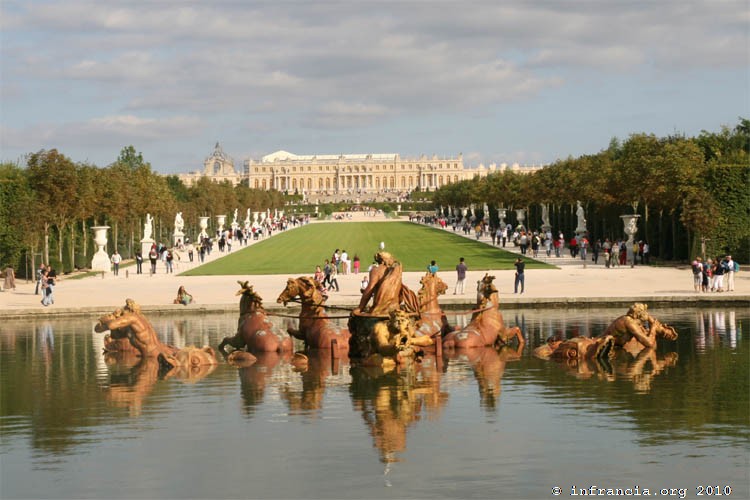Without simply repeating the lecture notes explain why Versailles Palace and Gardens were built, and the role they played during the rule of King Louis XIV
Louis XIV came to power in 1661 when he was 23 years old. During his 72 year reign, Louis XIV transformed not only the original hunting lodge of Versailles, but the reputation of France along with it. The renovations to the small chateau at Versailles began in 1662 as Louis’ interest in versailles increased. Beginning from around 1669 the chateau and its grounds were expanded into the palace and gardens f Versailles. It was not until 1682 that King Louis XIV made Versailles the Royal residence and court of France. Politically, the palace became the center of France and an extremely important representation of the power of Louis XIV.
When he was a child Louis spent many days at his fathers hunting lodge at Versailles. As he grew older Louis XIV found Paris unappealing and decided to expand his fathers hunting lodge and move his palace and court to Versailles. This he did on a monumental scale. The palace and grounds were expanded to house the entire Nobility and court of France. Larger than any palace before it, Versailles was the epitome of excess, decadence and power.
 The power dynamics of Versailles were developed on a foundation of paranoia. When he was a child, Louis had experienced an upper class revolt so-called the Fronde. The nobility tried to seize power from the previous king, but were unsuccessful. From this point on Louis was on edge when it came to the nobility. Thus, one of the significant aspects of Versailles is that it housed the court and nobility of France. With the nobility in such close proximity Louis was able to keep an eye on them as well as prevent them from accumulating a larger power base at home and keep them busy with infighting instead of fighting him. Further, the palace at Versailles insulated Louis from the mobs of Paris. Like a rather large sanctuary, Versailles was an outward expression that nobody could touch the power of France or Louis XIV.
The power dynamics of Versailles were developed on a foundation of paranoia. When he was a child, Louis had experienced an upper class revolt so-called the Fronde. The nobility tried to seize power from the previous king, but were unsuccessful. From this point on Louis was on edge when it came to the nobility. Thus, one of the significant aspects of Versailles is that it housed the court and nobility of France. With the nobility in such close proximity Louis was able to keep an eye on them as well as prevent them from accumulating a larger power base at home and keep them busy with infighting instead of fighting him. Further, the palace at Versailles insulated Louis from the mobs of Paris. Like a rather large sanctuary, Versailles was an outward expression that nobody could touch the power of France or Louis XIV.
The sheer size of the palace is enough to awe its visitors, but it is the gardens that truly stun the viewer. From the back of the palace one gazes upon an expanse of fountains, pools, groves and many groomed garden features. These gardens represented control, power, wealth, prestige and safety. They were used to entertain nobles and portray Louis’ power. Louis XIV is often referred to as the sun king. He loved the allegory of the sun and used its motif throughout the grounds of Versailles. Along the same line, Louis found the god Apollo to his liking. The fountain of Apollo is one of the main water features of Versailles and represents Louis’ ultimate power and wealth.
The impact of Versailles on the politics of Europe is hard to measure. For one, Louis XIV is still t this day the longest reigning monarch, which may speak to his power and the power of Versailles. However, it is difficult to measure the cultural impact of Versailles. The events that took place at Versailles shaped the course of French history up until the French Revolution and has had a lasting impact on architecture and gardens.
https://blogger.googleusercontent.com/img/b/R29vZ2xl/AVvXsEg8Azc0RzyAIp0p9Hze8cfS3_LYWEXdAnEQdA5zwOfCeeHmPZX9d_4CJQjKgcX_kNAQRSQo2uLtaHm4AfDSfP0O-gRRhm3VtunWQmsYOr8tEx5yui2kS8d05saLlrJfGJpESSUsaykG43Ll/s1600/jardim-palacio-versalhes.jpg
http://www.infrancia.org/ile-de-france/VERSAILLES/images/bassins_versailles_statue.jpg
Interesting sites for further reading:
http://www.britannica.com/EBchecked/topic/626457/Palace-of-Versailles
http://en.chateauversailles.fr/history-
http://travel.nationalgeographic.com/travel/world-heritage/versailles/
http://www.historylines.net/history/17th_cent/versailles.html
http://www.castles.org/castles/Europe/Western_Europe/France/france6.htm


No comments:
Post a Comment